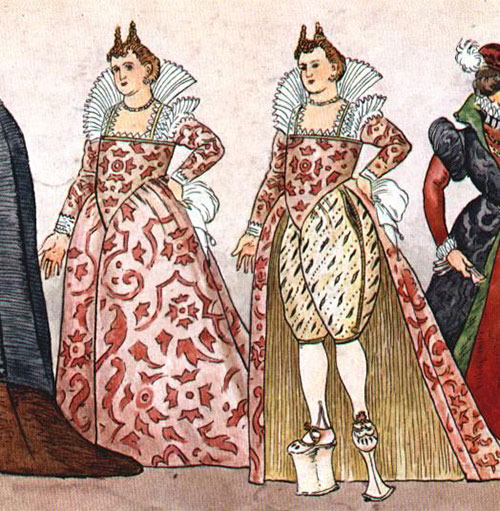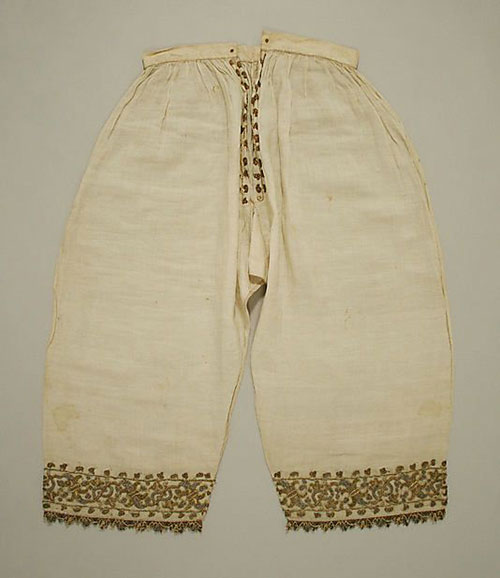 The history of underwear bottoms is very different from that of a chemise or shift. The male braies (a type of briefs used centuries ago) were in use for a long time but female pantaloons are a fairly modern invention – they appeared only in the mid-1500s. And even after that, women’s underwear bottoms changed, disappeared, came into fashion again, developed, and so on. It’s really interesting to learn the history of braies and pantaloons and compare them with our modern lingerie bottoms.
The history of underwear bottoms is very different from that of a chemise or shift. The male braies (a type of briefs used centuries ago) were in use for a long time but female pantaloons are a fairly modern invention – they appeared only in the mid-1500s. And even after that, women’s underwear bottoms changed, disappeared, came into fashion again, developed, and so on. It’s really interesting to learn the history of braies and pantaloons and compare them with our modern lingerie bottoms.
Men’s underwear
Throughout the Middle Ages, European gentlemen wore trouser-like garments called “braies”. Sometimes, they were underwear items with trousers worn on top, and in other cases, they were used as trousers without any other underpieces. Braies were loose-fitting and reached about knee-length or mid-calf. They were tied at the waist.
But in the Late Medieval – Early Modern era, braies became shorter and were turned into undergarments. Also, this period is the time when men started to use white hose – tight-fitting trousers that covered the whole leg and foot. It was hard to squeeze another pair of braies or trousers beneath, so men simply didn’t wear anything underneath the hose.
We’ve already mentioned in the article about chemises (Underwear in Europe in the Early Modern period: chemise or shift) that men often used their shifts as sort of briefs. They tucked the chemise inside the trousers and enfolded their intimate area with the hems of the shirt – the back bottom part went between the legs to the front and the front hem went to the back. That’s why men didn’t need any pantaloons in this case.

Portrait of Alessandro Farnese in Armor made around 1561 by Anthonis Mor and Alonso Sánchez Coello. Note a distinctive codpiece and white hose
Still, braies were popular among European males in the Early Modern period. They usually had a front flap called “codpiece” used for easier toilet access, like a modern zipper. The flap could be buttoned or laced closed. It was a very important part of male underwear in the 16th-17th century in Europe.
In the mid-late-16th century, codpiece fashion reached its peak. These items became decorative and emphasizing rather than just functional. Often, codpieces were padded. Some men even used a codpiece as a pocket to carry small items.
Women’s underwear
Women didn’t wear any pantaloons at all until the mid-1500s. The first pantaloons got into use not as an undergarment but as comfy pants which females wore for horse riding and similar activities. Also, many courtesans, especially Venetian courtesans, wore breeches similar to male ones. Later, these breeches transformed into underwear.

This is a 16th-century engraving “Cortigiana Veneza” (Venetian courtesan) by Pierto Bertelli, “Diversarum Nationum Habitus”, 1591. It was re-drawn and colored by Max Tilke in “A Pictorial History of Costume”, 1955. You can see decorative knee-length breeches here. Her gown is open at the front and the breeches are visible
In the 17th century, European women already used pantaloons as undergarments. It’s interesting that pantaloons disappeared in the 18th century and, until the end of the 1700s, females went without any bottom underwear pieces again. Then, pantaloons made a comeback and stayed for good.
By the way, the 19th-century pantaloons often had a totally different design from the earlier undergarments – they were open drawers with no crotch. Such a weird shape allowed women to use toilet more easily – remember those huge ball gowns with crinolines, bustles, and other complicated constructions?

Illustration from the book “Queen Elizabeth's Wardrobe Unlock'd” by Janet Arnold. These are women’s linen drawers from the late 16th century adorned with silk, gold, and silver embroidery. The Met collection
So, female pantaloons, pantalettes, drawers – you name it – are a comparatively modern invention. They’re only 500 years old. But it’s these undergarments that were the prototypes of our modern lingerie bottoms.


